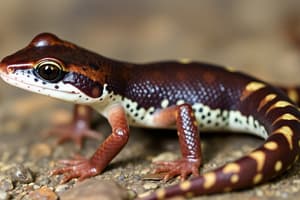Podcast
Questions and Answers
What is one unique characteristic of amphibians mentioned in the text?
What is one unique characteristic of amphibians mentioned in the text?
- Lay their eggs on land
- Undergo remarkable transformations from egg to tadpole (correct)
- Have feathers for insulation
- Have scales covering their bodies
Which of the following is NOT mentioned as a trait exhibited by some amphibians during development?
Which of the following is NOT mentioned as a trait exhibited by some amphibians during development?
- Practice flight before reaching adulthood (correct)
- Extract nutrients from parents
- Skip a free-swimming larval phase
- Develop directly inside eggs
What role do porous bodies play in amphibians' survival?
What role do porous bodies play in amphibians' survival?
- Prevent water loss
- Enhance hearing abilities
- Enable camouflage
- Facilitate gas exchange (correct)
Which factor is identified in the text as a primary cause of the closer extinction of over 300 amphibian species?
Which factor is identified in the text as a primary cause of the closer extinction of over 300 amphibian species?
Why do conservation efforts for amphibians often struggle to keep pace with the rate of decline?
Why do conservation efforts for amphibians often struggle to keep pace with the rate of decline?
In what way might amphibians be described according to the text?
In what way might amphibians be described according to the text?
Which of the following best describes the Global Amphibian Assessment project?
Which of the following best describes the Global Amphibian Assessment project?
What makes amphibians excellent models for laboratory research?
What makes amphibians excellent models for laboratory research?
What critical evidence have amphibians provided in supporting evolutionary theories?
What critical evidence have amphibians provided in supporting evolutionary theories?
How do amphibians contribute to maintaining ecological balance?
How do amphibians contribute to maintaining ecological balance?
What potential impact could the disappearance of amphibians have on ecosystems?
What potential impact could the disappearance of amphibians have on ecosystems?
Why do researchers prefer studying fundamental aspects of biology in amphibians rather than larger mammals?
Why do researchers prefer studying fundamental aspects of biology in amphibians rather than larger mammals?
Flashcards are hidden until you start studying
Study Notes
Exploring Amphibian Biology
Amphibians comprise an essential component of the natural world, with species ranging from tiny frogs to massive salamanders. Their intricate lives contribute to diverse ecosystem functions and serve as valuable subjects in scientific research.
Unique Characteristics
Amphibians combine traits found in no other taxonomic group. These creatures undergo remarkable transformations from egg to tadpole, followed by metamorphosis into adults with lungs or moist skins, depending on the species.
Amphibians exhibit a variety of developmental modes. Some skip a free-swimming larval phase altogether, instead developing directly inside eggs. Others practice parental care or even extract nutrients from their parents.
These dynamic organisms feature porous bodies allowing gas exchange, enabling their survival in unique environments spanning tropical rainforests to arctic regions.
Climate Change Impact
According to a major study led by CSUCI Assistant Professor Rudi von May, amphibians might be on the verge of mass extinction due to increasing temperatures. Between 2004 and 2022, more than 300 species faced closer extinction primarily as a result of climate change.
Challenges in Amphibian Conservation
Conservation efforts for amphibians often struggle to keep pace with the rapid rate of decline, particularly concerning the complex nature of factors driving population decreases. Practitioners focused on amphibian conservation may hold different definitions of success than scientists, leading to difficulties aligning goals.
Despite challenges experienced in amphibian conservation, numerous initiatives endeavor to preserve species and habitats. The Global Amphibian Assessment is a crucial project evaluating amphibian extinction risks worldwide, providing vital insights into the current status of amphibian biodiversity.
Contributions to Human Knowledge
Amphibians serve as excellent models for laboratory research, especially regarding physiology. Their simple body structures and well-defined developmental processes allow researchers to explore fundamental aspects of biology without the complications inherent to larger mammals.
Throughout history, amphibians have supplied critical evidence supporting evolutionary theories and revealed previously unknown mechanisms behind phenomena like limb regeneration and hormonal regulation.
Regarding broader societal impacts, amphibians help maintain ecological balance as prey, predators, and partners in symbiotic relationships. Their disappearance would disrupt entire ecosystems, potentially affecting human communities reliant upon balanced ecosystem dynamics.
Studying That Suits You
Use AI to generate personalized quizzes and flashcards to suit your learning preferences.




